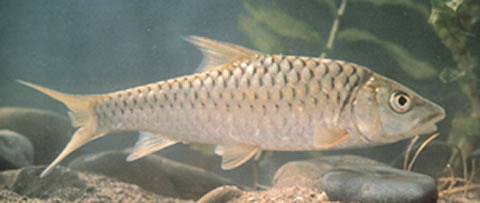| Cyprinidae (Minnows or carps), subfamily: Torinae |
| 46.5 cm SL (male/unsexed) |
|
benthopelagic; freshwater, potamodromous |
| Asia: China, Vietnam, and Laos; confined to the upper Mekong River system. |
|
Dorsal spines (total): 4-4; Dorsal soft rays (total): 7-9; Anal spines: 3-3; Anal soft rays: 5-5; Vertebrae: 41-43. Mentum long, usually reaching posteriorly to or beyond junction of upper and lower lips; soft oral structures tend to be more hypertrophied than in other Tor species, especially in larger individuals; gill rakers on lateral face of first gill arch 20-22; scales in lateral series 23-24; predorsal scales 8-10; transverse scale rows 4/1/2; vertebrae 25-27+15-16=41-43; juveniles overall silvery; pectoral, pelvic, anal, and caudal fins rosy to reddish; adults and subadults with a deep, dark midlateral stripe, body darkish above and brownish beneath; pectoral, pelvic, and caudal fins deep red (Ref. 35913). |
| Inhabits pools and runs over gravel and cobble in clear rivers in forest areas (Ref. 12693). Omnivorous, feeding on vegetable matter such as fruits, as well as fish, crustaceans and other invertebrates (Ref. 12693). Occasionally caught, but never in large numbers (Ref. 12693). |
|
Vulnerable (VU); Date assessed: 20 April 2018 (B2ab(iii)) Ref. (130435)
|
| harmless |
Source and more info: www.fishbase.org. For personal, classroom, and other internal use only. Not for publication.

